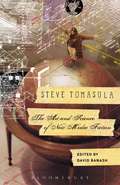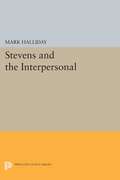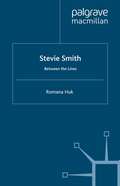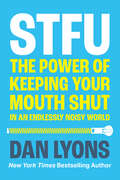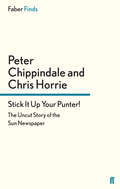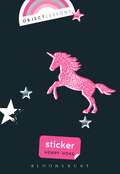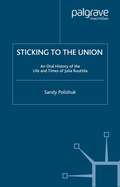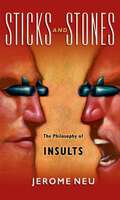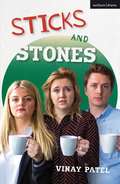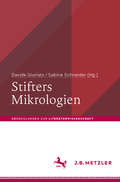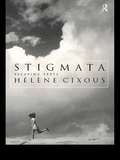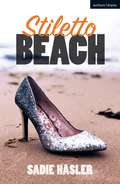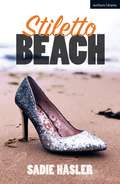- Table View
- List View
Steve Tomasula: The Art and Science of New Media Fiction
by David BanashSteve Tomasula's work exists at the cutting edges of scientific knowledge and literary techniques. As such, it demands consideration from multiple perspectives and from critics who can guide the reader through the formal innovations and multimedia involutions while providing critical scientific, aesthetic, historical, and technical contexts. This book, the first of its kind, provides this framework, showing readers the richness and relevance of the worlds Tomasula constructs.Steve Tomasula's work is redefining the form of the novel, reinventing the practice of reading, and wrestling with the most urgent questions raised by massive transformations of media and biotechnologies. His work not only charts these changes, it formulates the problems that we have making meaning in our radically changing technological contexts. Vast in scope, inventive in form, and intimate in voice, his novels, short stories, and essays are read and taught by a surprisingly diverse array of scholars in fields ranging from contemporary experimental writing and literary criticism to the history of science, biotechnology and bioart, book studies, and digital humanities.
Stevens and the Interpersonal
by Mark HallidayWith Wallace Stevens emerging as a father figure for American poetry of the late twentieth century, Mark Halliday argues that it is time for this "poet of ideas" to undergo an ethical critique. In this bold, accessible reconsideration of Stevens' work, he insists on the importance of interpersonal relations in any account of human life in the modern world. Although Stevens outwardly denies aspects of life that center on such relations as those between friends, lovers, family members, and political constituents, Halliday uncovers in his poetry an anxious awareness of the importance of these relations. Here we see the difficulties Stevens made for himself in wanting to offer a thoroughly satisfying version of secular spiritual health in the modern world without facing up to the moral and psychological implications of his own interpersonal needs, problems, and responsibilities. The final chapter reveals, however, an unusually encouraging "avuncular" attitude toward the reader of the poetry, which may be felt to redeem Stevens from the alienation observed earlier. Halliday develops his views by way of comparisons between Stevens and other poets, especially Thomas Hardy, Emily Dickinson, Robert Frost, and John Ashbery.Originally published in 1991.The Princeton Legacy Library uses the latest print-on-demand technology to again make available previously out-of-print books from the distinguished backlist of Princeton University Press. These editions preserve the original texts of these important books while presenting them in durable paperback and hardcover editions. The goal of the Princeton Legacy Library is to vastly increase access to the rich scholarly heritage found in the thousands of books published by Princeton University Press since its founding in 1905.
Stevens' Poetry of Thought
by Frank DoggettOriginally published in 1966. This book is the first full-length study of Wallace Stevens as a thinker. With original insight, Mr. Doggett provides many detailed interpretations of individual poems in examining Steven's imagery. This is a pertinent treatment of Stevens' inherent affinity with the philosophic imagination of his time, showing how firmly this poet was linked through his images with the leading thinkers of the age just passed—especially Schopenhauer, Bergson, Santayana, Whitehead, William James, Jung, and Cassirer. The clear and perceptive reading of a great many of the poems in this book should illuminate the work of Stevens for all the readers who admire his language and wish for further insight into its significance. Beyond being a definitive exposition of Steven' poetry and a meaningful act of faith in the intellectual sophistication of Stevens, this is an exciting study of the human imagination which satisfies the need for distinction between poetry and philosophy while illuminating one by the other. Mr. Doggett demonstrates how the poetry of Stevens is a representative voice of the ideas of his age and illustrates Stevens own statement: "Poets and philosophers often think alike, as we shall see." Wallace Stevens is now recognized as one of the most important American poets of the twentieth century. His first volume of poems, Harmonium was published in 1923, and since then seven volumes of his work have appeared. He was awarded the Bollingen Prize in Poetry of the Yale University Library for 1949. In 1951 he won the National Book Award in Poetry for The Auroras of Autumn. The Collected Works of Wallace Stevens was awarded the Pulitzer Prize in Poetry in 1955. From 1916 to his death in 1955 he was associated with the Hartford Accident and Indemnity Company, of which he became vice-president in 1934.
Stevens' Poetry of Thought
by Frank DoggettOriginally published in 1966. This book is the first full-length study of Wallace Stevens as a thinker. With original insight, Mr. Doggett provides many detailed interpretations of individual poems in examining Steven's imagery. This is a pertinent treatment of Stevens' inherent affinity with the philosophic imagination of his time, showing how firmly this poet was linked through his images with the leading thinkers of the age just passed—especially Schopenhauer, Bergson, Santayana, Whitehead, William James, Jung, and Cassirer. The clear and perceptive reading of a great many of the poems in this book should illuminate the work of Stevens for all the readers who admire his language and wish for further insight into its significance. Beyond being a definitive exposition of Steven' poetry and a meaningful act of faith in the intellectual sophistication of Stevens, this is an exciting study of the human imagination which satisfies the need for distinction between poetry and philosophy while illuminating one by the other. Mr. Doggett demonstrates how the poetry of Stevens is a representative voice of the ideas of his age and illustrates Stevens own statement: "Poets and philosophers often think alike, as we shall see." Wallace Stevens is now recognized as one of the most important American poets of the twentieth century. His first volume of poems, Harmonium was published in 1923, and since then seven volumes of his work have appeared. He was awarded the Bollingen Prize in Poetry of the Yale University Library for 1949. In 1951 he won the National Book Award in Poetry for The Auroras of Autumn. The Collected Works of Wallace Stevens was awarded the Pulitzer Prize in Poetry in 1955. From 1916 to his death in 1955 he was associated with the Hartford Accident and Indemnity Company, of which he became vice-president in 1934.
Stevie Smith: Between the Lines
by R. HukIn this first book-length study of Stevie Smith, Romana Huk reassesses the work of this major twentieth-century woman writer as emerging not only from the practices of female literary modernism, but also from within the tumultuous cultural context of mid-century Europe. Huk considers both the poems and the novels in the light of their cultural and literary context. Amongst the work treated here is Smith's rarely discussed trilogy of novels: Novel on Yellow Paper , Over the Frontier and The Holiday .
Stevie Smith and the Aphorism: Hard Language (Oxford English Monographs)
by Noreen MasudThis volume argues that aphorism represents a tool for the social management of emotion. Rhetorically corralled into a slick, collectable shape, the aphorism promises arresting and instantaneous epiphany. However, the accomplished elegance which positions the aphorism's message as self-evidently true in fact works to repel further enquiry, and ultimately ensures that it will be forgotten or bypassed in favour of another aphorism: no less eagerly embraced for the earlier disappointment. Aphorism, therefore, is a form in which dangerous ideas and emotions can be safely displayed and, simultaneously, effaced. Because aphorism's style defuses the imperative to act on what is clearly known, writers like Stevie Smith can use the form to stage a withdrawal from the burden of making an impact on the world. This book finds that Smith's use of aphorism and its related forms (proverb, epitaph, caption, and fragment) offers a route into her texts. With her disconcerting pen-and-ink drawings, dark comedy, and social ventriloquism which stops short of satire, the rhetorical force of Smith's poetry fascinates and arrests its readers, but nevertheless leaves them unable to react coherently or identify the use-value which her writing appears to promise. Drawing on hitherto unpublished archival material, this project argues that Smith's texts resist analysis because, like the aphorisms embedded throughout them, they offer and exemplify a mode of clearly-declared revelation which, at the same time, makes itself unusable.
Stevie Smith and the Aphorism: Hard Language (Oxford English Monographs)
by Noreen MasudThis volume argues that aphorism represents a tool for the social management of emotion. Rhetorically corralled into a slick, collectable shape, the aphorism promises arresting and instantaneous epiphany. However, the accomplished elegance which positions the aphorism's message as self-evidently true in fact works to repel further enquiry, and ultimately ensures that it will be forgotten or bypassed in favour of another aphorism: no less eagerly embraced for the earlier disappointment. Aphorism, therefore, is a form in which dangerous ideas and emotions can be safely displayed and, simultaneously, effaced. Because aphorism's style defuses the imperative to act on what is clearly known, writers like Stevie Smith can use the form to stage a withdrawal from the burden of making an impact on the world. This book finds that Smith's use of aphorism and its related forms (proverb, epitaph, caption, and fragment) offers a route into her texts. With her disconcerting pen-and-ink drawings, dark comedy, and social ventriloquism which stops short of satire, the rhetorical force of Smith's poetry fascinates and arrests its readers, but nevertheless leaves them unable to react coherently or identify the use-value which her writing appears to promise. Drawing on hitherto unpublished archival material, this project argues that Smith's texts resist analysis because, like the aphorisms embedded throughout them, they offer and exemplify a mode of clearly-declared revelation which, at the same time, makes itself unusable.
STFU: The Power Of Keeping Your Mouth Shut In A World That Won't Stop Talking
by Dan LyonsWould our lives, relationships and careers be better if we just STFU for a while?
Stick It Up Your Punter!: The Uncut Story of the Sun Newspaper
by Chris Horrie Peter ChippindaleNewly updated to 2012 and the Leveson Inquiry, Stick It Up Your Punter! is the classic story of the Sun newspaper, its part in the rise of Rupert Murdoch's business empire, and the extraordinary role it came to play in British society and politics. From Murdoch's purchase and rebranding of the old loss-making Sun in 1969, through the soaraway-successful and often scandalous years of success under foul-mouthed editor Kelvin MacKenzie, to the 'phone-hacking' disgrace of 2012 which put Murdoch's business affairs under scrutiny as never before - this is the story of the paper that, for better or worse, redefined 'tabloid journalism'.'[This] anarchic account... could be a script for Carry On Up Fleet Street.' Alan Rusbridger, Guardian'The funniest book of the year, perhaps of the decade.' Times'Splendidly racy.' Economist'A story which social and political historians of the 20th century will not find easy to ignore.' London Review of Books
Sticker (Object Lessons)
by Henry HokeObject Lessons is a series of short, beautifully designed books about the hidden lives of ordinary things.Stickers adorn our first memories, dot our notebooks and our walls, are stuck annoyingly on fruit, and accompany us into adulthood to announce our beliefs from car bumpers. They hold surprising power in their ability to define and provoke, and hold a strange steadfast presence in our age of fading physical media. Henry Hoke employs a constellation of stickers to explore queer boyhood, parental disability, and ancestral violence. A memoir in 20 stickers, Sticker is set against the backdrop of the encroaching neo-fascist presence in Hoke's hometown of Charlottesville, Virginia, which results in the fatal terrorist attack of August 12th and its national aftermath. Object Lessons is published in partnership with an essay series in The Atlantic.
Sticker (Object Lessons)
by Henry HokeObject Lessons is a series of short, beautifully designed books about the hidden lives of ordinary things.Stickers adorn our first memories, dot our notebooks and our walls, are stuck annoyingly on fruit, and accompany us into adulthood to announce our beliefs from car bumpers. They hold surprising power in their ability to define and provoke, and hold a strange steadfast presence in our age of fading physical media. Henry Hoke employs a constellation of stickers to explore queer boyhood, parental disability, and ancestral violence. A memoir in 20 stickers, Sticker is set against the backdrop of the encroaching neo-fascist presence in Hoke's hometown of Charlottesville, Virginia, which results in the fatal terrorist attack of August 12th and its national aftermath. Object Lessons is published in partnership with an essay series in The Atlantic.
Sticking to the Union: An Oral History of the Life and Times of Julia Ruuttila (Palgrave Studies in Oral History)
by S. PolishukSticking to the Union relates the vibrant life of Julia Ruuttila (1907-1991), a political radical and labor journalist in the Pacific Northwest. Ruuttila's life of activism provides a much-needed woman's voice in the history of labor and social activism in the twentieth century. Ruuttila worked for civil liberties, civil rights, and peace organizations throughout her life, supporting striking workers, taking part in lunch-counter protests against businesses that discriminated against African Americans, and demonstrating against the Vietnam War. Polishuk provides insightful historical context for Ruuttila's own lively words. A unique and important perspective on American struggles of the twentieth century emerges in this engaging story of an irrepressible, hard-nosed woman.
Sticks and Stones: The Philosophy of Insults
by Jerome Neu"Sticks and stones may break my bones but words will never hurt me." This schoolyard rhyme projects an invulnerability to verbal insults that sounds good but rings false. Indeed, the need for such a verse belies its own claims. For most of us, feeling insulted is a distressing-and distressingly common-experience. In Sticks and Stones, philosopher Jerome Neu probes the nature, purpose, and effects of insults, exploring how and why they humiliate, embarrass, infuriate, and wound us so deeply. What kind of injury is an insult? Is it determined by the insulter or the insulted? What does it reveal about the character of both parties as well as the character of society and its conventions? What role does insult play in social and legal life? When is telling the truth an insult? Neu draws upon a wealth of examples and anecdotes-as well as a range of views from Aristotle and Oliver Wendell Holmes to Oscar Wilde, John Wayne, Katherine Hepburn, and many others-to provide surprising answers to these questions. He shows that what we find insulting can reveal much about our ideas of character, honor, gender, the nature of speech acts, and social and legal conventions. He considers how insults, both intentional and unintentional, make themselves felt-in play, Freudian slips, insult humor, rituals, blasphemy, libel, slander, and hate speech. And he investigates the insult's extraordinary power, why it can so quickly destabilize our sense of self and threaten our moral identity, the very center of our self-respect and self-esteem. Entertaining, humorous, and deeply insightful, Sticks and Stones unpacks the fascinating dynamics of a phenomenon more often painfully experienced than clearly understood.
Sticks and Stones: The Philosophy of Insults
by Jerome Neu"Sticks and stones may break my bones but words will never hurt me." This schoolyard rhyme projects an invulnerability to verbal insults that sounds good but rings false. Indeed, the need for such a verse belies its own claims. For most of us, feeling insulted is a distressing-and distressingly common-experience. In Sticks and Stones, philosopher Jerome Neu probes the nature, purpose, and effects of insults, exploring how and why they humiliate, embarrass, infuriate, and wound us so deeply. What kind of injury is an insult? Is it determined by the insulter or the insulted? What does it reveal about the character of both parties as well as the character of society and its conventions? What role does insult play in social and legal life? When is telling the truth an insult? Neu draws upon a wealth of examples and anecdotes-as well as a range of views from Aristotle and Oliver Wendell Holmes to Oscar Wilde, John Wayne, Katherine Hepburn, and many others-to provide surprising answers to these questions. He shows that what we find insulting can reveal much about our ideas of character, honor, gender, the nature of speech acts, and social and legal conventions. He considers how insults, both intentional and unintentional, make themselves felt-in play, Freudian slips, insult humor, rituals, blasphemy, libel, slander, and hate speech. And he investigates the insult's extraordinary power, why it can so quickly destabilize our sense of self and threaten our moral identity, the very center of our self-respect and self-esteem. Entertaining, humorous, and deeply insightful, Sticks and Stones unpacks the fascinating dynamics of a phenomenon more often painfully experienced than clearly understood.
Sticks and Stones (Modern Plays)
by Vinay Patel“So we're clearYou know, right?You know I'm not that kind of person”Sometimes we can't find the right words. Sometimes the wrong word just slips out. Sometimes the right words become the wrong words. Sometimes that ruins everything.When a misfiring joke turns their life upside down, B sets off on a surreal journey looking for answers. In an age when technology multiplies every mistake, can we find a way to understand each other?A razor sharp satire about the search for a sure footing in an uncertain world from BAFTA nominated Vinay Patel. This edition was published to coincide with the premiere at Paines Plough and produced by Theatr Clwyd.
Sticks and Stones (Modern Plays)
by Vinay Patel“So we're clearYou know, right?You know I'm not that kind of person”Sometimes we can't find the right words. Sometimes the wrong word just slips out. Sometimes the right words become the wrong words. Sometimes that ruins everything.When a misfiring joke turns their life upside down, B sets off on a surreal journey looking for answers. In an age when technology multiplies every mistake, can we find a way to understand each other?A razor sharp satire about the search for a sure footing in an uncertain world from BAFTA nominated Vinay Patel. This edition was published to coincide with the premiere at Paines Plough and produced by Theatr Clwyd.
Stieg Larsson's Millennium Trilogy: Interdisciplinary Approaches to Nordic Noir on Page and Screen
by Steven PeacockUniquely placed to explore the worldwide phenomenon of Stieg Larsson's Millennium trilogy beginning with The Girl with the Dragon Tattoo, the book offers the first full-length study of Larsson's work in both its written and filmed forms.
Stifter-Handbuch: Leben – Werk – Wirkung
by Christian Begemann Davide GuiriatoWie kaum ein anderer Autor des Realismus ist Adalbert Stifter in den letzten 25 Jahren grundlegenden Umdeutungen unterzogen worden. Zu seinem 150. Todestag bietet das Stifter-Handbuch nicht nur einen Überblick über sein Werk, dessen Entstehung und Rezeption sowie die verschiedenen Ansätze der literaturwissenschaftlichen Forschung, sondern setzt auch neue Akzente. Stifters Erzählungen, Romane und Aufsätze werden zum einen unter philologischen Gesichtspunkten und mit Blick auf neueste Forschungsergebnisse detailliert dargestellt, zum anderen in ihre poetologischen und ästhetischen Horizonte eingeordnet. Ausführlich untersucht werden die für Stifter maßgeblichen wissensgeschichtlichen Kontexte (wie etwa Botanik, Geologie, Meteorologie, Ökonomie, Pädagogik), bevor das Werk abschließend über bestimmte Problemfelder erschlossen wird (Ordnung, Wiederholung, Ritual, Dinge, Genealogie, Erbe u.a.).
Stifters Mikrologien (Abhandlungen zur Literaturwissenschaft)
by Davide Giuriato Sabine SchneiderDas Werk Adalbert Stifters zeichnet sich durch eine markante Aufmerksamkeit für das Kleine und vermeintlich Geringfügige aus, er gilt als Dichter des Details. Bereits die zeitgenössische Kritik hat sein „Diminutivtalent“ und Interesse für das „Kleinleben der Natur“ ins Visier genommen. So wie sich die Humanwissenschaften methodologisch auf die unwichtigen Nebensächlichkeiten, auf das Netz von geringfügigen Indizien und Symptomen zu stützen beginnen, so entdeckt dieser Sammelband Stifters Mikrologie als eine „unsichere Wissenschaft“, die sich gerade über unmerkliche Wahrnehmungen Aufschluss über größere Zusammenhänge erhofft. Der Zusammenhang von Literatur und Wissen, der hier aufgedeckt wird, bezieht sich auf Natur ebenso wie auf soziale Phänomene und beschreibt einen wesentlichen Aspekt der Poetologie Stifters.
Stigmata: Escaping Texts
by Hélène CixousA 'wilful extremist' according to the London Times, Hélène Cixous is hailed as one of the most formidable writers and thinkers of our time. Acclaimed by luminaries such as Jacques Derrida, her writing has nonetheless been misunderstood and misread, to a surprising extent. With the inclusion of Stigmata, one of her greatest works into the Routledge Classics series, this is about to change. Questions that have long concerned her – the self and the other, autobiographies of writing, sexual difference, literary theory, post-colonial theory, death and life – are explored here, woven into a stunning narrative. Displaying a remarkable virtuosity, the work of Cixous is heady stuff indeed: exciting, powerful, moving, and dangerous.
Stigmata: Escaping Texts
by Hélène CixousA 'wilful extremist' according to the London Times, Hélène Cixous is hailed as one of the most formidable writers and thinkers of our time. Acclaimed by luminaries such as Jacques Derrida, her writing has nonetheless been misunderstood and misread, to a surprising extent. With the inclusion of Stigmata, one of her greatest works into the Routledge Classics series, this is about to change. Questions that have long concerned her – the self and the other, autobiographies of writing, sexual difference, literary theory, post-colonial theory, death and life – are explored here, woven into a stunning narrative. Displaying a remarkable virtuosity, the work of Cixous is heady stuff indeed: exciting, powerful, moving, and dangerous.
Stigmata: Escaping Texts
by Hélène CixousHèléne Cixous -- author, playwright and French feminist theorist -- is a key figure in twentieth-century literary theory. Stigmata brings together her most recent essays for the first time.Acclaimed for her intricate and challenging writing style, Cixous presents a collection of texts that get away -- escaping the reader, the writers, the book. Cixous's writing pursues authors such as Stendhal, Joyce, Derrida, and Rembrandt, da Vinci, Picasso -- works that share an elusive movement in spite of striking differences. Along the way these essays explore a broad range of poetico-philosophical questions that have become characteristic of Cixous' work:* love's labours lost and found* feminine hours* autobiographies of writing* the prehistory of the work of artStigmata goes beyond theory, becoming an extraordinary writer's testimony to our lives and times.
Stigmata: Escaping Texts
by Hélène CixousHèléne Cixous -- author, playwright and French feminist theorist -- is a key figure in twentieth-century literary theory. Stigmata brings together her most recent essays for the first time.Acclaimed for her intricate and challenging writing style, Cixous presents a collection of texts that get away -- escaping the reader, the writers, the book. Cixous's writing pursues authors such as Stendhal, Joyce, Derrida, and Rembrandt, da Vinci, Picasso -- works that share an elusive movement in spite of striking differences. Along the way these essays explore a broad range of poetico-philosophical questions that have become characteristic of Cixous' work:* love's labours lost and found* feminine hours* autobiographies of writing* the prehistory of the work of artStigmata goes beyond theory, becoming an extraordinary writer's testimony to our lives and times.
Stiletto Beach (Modern Plays)
by Sadie HaslerBest mates Leanne and Kelly have lived in Southend-on-Sea their whole lives. Larger-than-life Leanne is happy staying put, but Kelly secretly dreams of escaping her dull job and seeing the world.When out-of-towner journalist Helen can't afford Leigh-on-Sea so moves in next door instead, events take a surprising turn. As Leanne and Kelly take her under their wing, an unexpected friendship blooms in Spoons, and Helen soon has them reconsidering what it means to celebrate where you're from.With the help of Leanne's Nan, east-ender Roni, they take a sharp swipe at stereotypes women have been putting up with for decades. Mischief ensues, fires are lit, and the Essex girls do what's in their blood: cause trouble – but not in a way anyone would expect…
Stiletto Beach (Modern Plays)
by Sadie HaslerBest mates Leanne and Kelly have lived in Southend-on-Sea their whole lives. Larger-than-life Leanne is happy staying put, but Kelly secretly dreams of escaping her dull job and seeing the world.When out-of-towner journalist Helen can't afford Leigh-on-Sea so moves in next door instead, events take a surprising turn. As Leanne and Kelly take her under their wing, an unexpected friendship blooms in Spoons, and Helen soon has them reconsidering what it means to celebrate where you're from.With the help of Leanne's Nan, east-ender Roni, they take a sharp swipe at stereotypes women have been putting up with for decades. Mischief ensues, fires are lit, and the Essex girls do what's in their blood: cause trouble – but not in a way anyone would expect…
